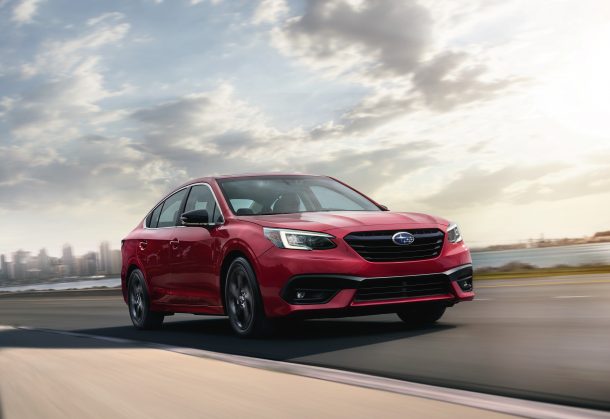Having Pulled Off Another Win, Subaru Predicts Yet Another

You read on Friday how Subaru exceeded its U.S. sales goal for 2019 by 117 vehicles, pushing its American volume to the highest point in the automaker’s history — up 2.9 percent from 2018, and more than 200 percent greater than its tally just a decade prior. A hard thing to achieve in a market that cooled off in 2019.
Subaru doesn’t see last year as a high water mark, however. For 2020, the brand has even loftier expectations, but everything will have to fall into place for it to happen.
With two shadowy products on the way but not imminent, Subaru will have to rely on boosted production of existing models, two of them revamped for the 2020 model year, as well as improved quality.
Both of these elements are in the process of being fixed, says CEO Tomomi Nakamura, formerly head of Subaru’s American arm. The brand’s head honcho freed up $1 billion to improve quality control after recalls earned it a black eye. Meanwhile, the brand’s wildly low 24-day supply of new vehicles in December will improve through increased output at the automaker’s Japanese and Indiana assembly plants, Automotive News reports.
Speaking at a media event last month, Nakamura said he wants to see an average of 45 days’ worth of new vehicles in 2020, adding that some models, such as the Impreza-based Crosstrek, ended the year with a 12-day supply. The industry average is north of 60, and sometimes even 70.
“We will be revamping our inventory around that number,” he said of the 45-day figure. “We may be able to hit an overall average of 45 days’ supply in the near future.”
Unlike larger automakers, Subaru’s sparse production footprint gives it the unusual ability to quickly unload all of the vehicles it builds. With overall sales on the rise, boosting capacity is a must. Output in Indiana is expected to rise by 30,000 vehicles this year, Nakamura said.
As for product itself, the CEO feels the redesigned Legacy and its wagon sibling, the Outback, will return greater sales in 2020, helping overall volume that received a big boost from the addition of the Ascent midsizer in mid-2018. Sales of the revamped-but-still-true-to-itself Forester also rose in 2019.
So, what’s the expectation for 2020? Volume of 720,ooo to 730,000, apparently.
“There is still growth possibility in the United States,” Nakamura told reporters, adding, “We think it is still possible for us to grow in the U.S. Sunbelt. We think that’s a frontier market for us. But it’s not just the Sunbelt. There is also the Snowbelt, especially the Northeast.”
While buyers in, say, Vermont have certainly adopted Subaru as a preferred brand, consumers in the sunny South have proven a harder nut to crack. There’s great regional differences in brand loyalty in the U.S., with various elements in play — among them, socioeconomic factors, consumer ethnicity, brand image, and weather. Standard full-time all-wheel drive is obviously a bigger draw in areas where there’s good reason to lose traction.
As for those two upcoming models, one is an electric crossover co-developed with Toyota. The other, billed as a global SUV, remains hazy, destined for a segment the automaker hasn’t yet revealed. Whatever the form these vehicles take, they won’t be on sale in 2020.
[Images: Subaru]

More by Steph Willems
Latest Car Reviews
Read moreLatest Product Reviews
Read moreRecent Comments
- SCE to AUX "...to help bolster job growth and the local economy"An easy win for the politicians - the details won't matter.
- Kjhkjlhkjhkljh kljhjkhjklhkjh so now we will PAY them your tax money to build crappy cars in the states ..
- SCE to AUX Yes, I'll miss it, and it doesn't make sense to kill off your 3rd-best seller. 2023 was its best year since 2018.
- SCE to AUX This was the same car I had (05 xB, stick, "camouflage" color) for 7 years - great car.We called ours "The Lunchbox". I added aftermarket wheels, and the 3rd-party cruise control the dealers could install.It suffered only two failures: bad window switch in week 2 (dealer fixed in 1 hour), bad trailing O2 sensor (fixed myself for $70). Fuel economy was always 28-34 mpg.It was a potential death trap, and ride quality became unbearable after 2 hours. I once did a 10-hour round trip in it and could barely walk after.Traded it for a 2012 Leaf, which was a better car in some ways.
- Bd2 The "e" nomenclature signifies the e-ATPs which BMW is pursuing.



































Comments
Join the conversation
Subaru is best known for super-symmetric AWD.
I'm confused. Why is having a 24 day supply necessarily a bad thing? Wouldn't this indicate that they've forecasted the demand appropriately, and isn't this how they manage to sell their wares without resorting to incentive spending? Wasn't it just the other day there was the story of incentive spending and Subaru was at the bottom of the back with something like $1,500 per car? Couldn't more manufacturers learn from Subaru, the relative quality or lack thereof being an entirely separate issue? I'm genuinely curious.